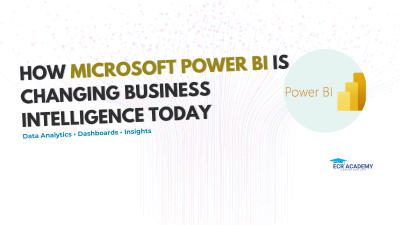
Oluyi Segun
 Microsoft Power BI
Microsoft Power BI
 0 comment
0 comment
 18 Aug, 2025
18 Aug, 2025

Microsoft Power BI is a business analytics tool that transforms raw data into actionable insights. It allows business users, analysts, and developers to connect to multiple data sources, create interactive dashboards and share reports across teams in real time.
Power BI is also a core part of Microsoft Fabric, the platform that combines analytics, data engineering, and AI under one system. What sets Power BI apart is its ability to deliver interactive reports, provide an accessible online service (Power BI Service), and build dashboards designed for decision-making.
Before moving further, it is important to define business intelligence.
Business intelligence (BI) is the use of technology to collect, organize, and analyze data so businesses can turn it into insights that guide both daily operations and long-term strategy.
In practice, BI turns raw data such as sales figures, customer feedback, or social media activity into information that leaders can act on. Modern BI tools make this possible by connecting to a wide range of data sources, whether historical or real-time, internal or external, structured or unstructured.
How does Microsoft Power BI fit into the BI ecosystem?
Microsoft Power BI software integrates tightly with other Microsoft services such as Synapse for advanced analytics and Data Factory for building data pipelines. It relies on shared features like dataflows, OneLake, and enterprise security to ensure a consistent foundation for analytics across teams. For example, OneLake serves as a central storage hub, and Power BI can access this data directly through Direct Lake mode without duplication or lengthy refresh cycles.
Image for the Fabric
Power BI also makes data analytics more accessible. Users can connect to multiple data sources, create reports, and publish dashboards without deep technical skills. With Copilot AI, they can ask natural language questions to generate reports or identify trends, making business intelligence more usable across an organization.
This seamless integration is what makes Microsoft Power BI important within the BI ecosystem as it connects data pipelines, enable visualization, and deliver insights for faster decision-making.
Now that we have seen how Microsoft Power BI software fits into the BI ecosystem, let’s look at real-world cases where organizations improved decision-making with Power BI dashboards and analytics.
Between 2018 and 2019, Metro Bank replaced static Excel reports with more than 100 live Power BI dashboards. This transition allowed managers to track real-time updates across call centers, mobile banking, and customer complaints in a way that improve both responsiveness and customer experience.
Automating Manufacturing Reports
A pest management manufacturing firm previously that usually spent hours downloading data from Microsoft Dynamics GP and merging spreadsheets manually. With Power BI software, they were able to build automated dashboards that improved accuracy, reduced reporting time, and strengthened decision-making across production and logistics.
Logistics Integration
In 2024, a logistics company used Power BI data analytics to integrate GPS and traffic data into its dashboards that led to more efficient route planning and reduced fuel costs by up to 15 percent.
These few examples show how Power BI is reshaping industries by turning raw data into business intelligence.
Major Features of Microsoft Power BI
Microsoft Power BI comes with a set of business intelligence tools that make it one of the most widely used data visualization and analytics platforms today. These features help users move from raw data to meaningful insights faster and more efficiently.
These features demonstrate why Microsoft Power BI is more than a BI tool, it is a complete data analysis and visualization solution for modern organizations.
Getting Started with Power BI
Microsoft Power BI offers entry-level tools that make data analytics approachable for beginners and at the same time powerful for advanced users. These options help you connect to data, create dashboards, and share insights across teams.
Power BI Desktop
Power BI Desktop is a free Windows application for building reports and performing data analytics. You can connect to multiple data sources, clean and transform your data, and design interactive dashboards before publishing them on Power BI Service.
Power BI Service
Power BI Service, also known as Power BI Online, is a secure cloud-based workspace for sharing and collaborating on reports. It supports scheduled data refresh, centralized dashboards, and permissions management so all users access the same updated information.
The Power BI Mobile App allows users to view dashboards and reports on the go. Whether in a meeting, commuting, or working remotely, it allows decision-makers to connect to explore reports anytime and anywhere.
If you are ready to start learning Microsoft Power BI, the best place to begin is with the Data Analysis with Power BI course on ECR Academy.
This course is designed for beginners who want to move from raw data to insights with confidence. Instead of overwhelming you with theory, it breaks down Power BI into clear, step-by-step lessons that cover data analysis, report building, and dashboard creation.
By the end of the course, you will know how to:
Whether your goal is to improve business decision-making or build a career in data analytics, this course provides the structure and guidance you need to succeed.
Oluyi Segun
0 comment